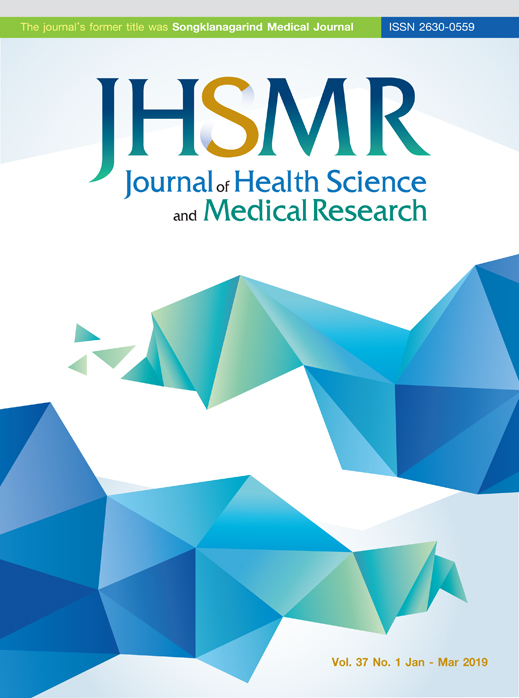A Study of Entrance Surface Air Kerma for Patients Undergoing Chest and Abdomen from Digital Radiography at Chulabhorn Hospital
DOI:
https://doi.org/10.31584/jhsmr.201940Keywords:
abdomen, chest, digital radiography, entrance surface air kermaAbstract
Objective: The main purpose of this study was to investigate the typical dose for standard-sized patients in chest (posteroanterior; PA) and abdomen (anteroposterior; AP) digital radiography.
Material and Methods: The air kerma was measured by the ionization chamber (Radical Corporation, model 10X6-6) in X-ray equipment manufactured by General Electric Healthcare Definium 8000 System for different kilovoltage peak (kVp) settings in each X-ray examination. The entrance surface air kerma (ESAK) was determined in 422 mediumsized patients in different projections: chest (PA) and abdomen (AP), according to the recommended protocol of the International Atomic Energy Agency Technical Report Series Number 457 (Technical Reports Series No. 457 “Dosimetry in Diagnostic Radiology: An International Code of Practice).
Results: The mean entrance surface air kerma values for chest (PA) radiography in female and male patients were 0.08 milligray (mGy) and 0.09 mGy, respectively and for abdomen (AP) radiography for both genders were 0.98 mGy and 1.06 mGy, respectively.
Conclusion: The mean entrance surface air kerma values of this study were less than the diagnostic reference levels from the IAEA 1996, Korea 2007, United Kingdom 2010 and Japan 2015, in all projections. Patient doses (ESAK) in chest (PA) and abdomen (AP) digital radiography at Chulabhorn Hospital were less than the other guidelines, because of the use of a high kVp technique for the chest and the automatic exposure control for the abdomen. Furthermore, Thai people are smaller than Westerners. We studied in digital radiography only that literally provides lowest radiation dose compares with screen film and computed radiography.
References
2. Aldrich JE, Duran E, Dunlop P, Mayo JR. Optimization of dose and image quality for computed radiography and digital radiography. J Digit Imaging 2006;19:126-31.
3. International Atomic Energy Agency. Diagnostic radiology physics: a handbook for teachers and students. Vienna: IAEA;2014.
4. Diagnostic reference levels in medical imaging: review and additional advice. Ann ICRP 2001;31:33-52.
5. Kim YH, Choi JH, Kim CK, Kim JM, Kim SS, Oh YW, et al. Patient dose measurements in diagnostic radiology procedures in Korea. Radiat Prot Dosimetry 2007;123:540-5.
6. Buncharat S, Hamuttiti P. Patient doses in simple radiographic examinations in Trang, Phatthalung and Satun Provinces in Transition from X-ray film to computed radiography. J Health Sci 2016;25:632-40.
7. Wanai A, Kongaew P. Entrance surface dose level of common diagnostic X-ray examinations at Songklanagarind Hospital. Songkla Med J 2011;29:57-64.
8. Yonekura Y. Diagnostic reference levels based on latest surveys in Japan - Japan DRLs 2015 [monograph on the
Internet]. Chiba: Japanese Network for Research and Information on Medical Exposure; 2015 [cited 2016 Nov 4].
Available from: https://www.radher.jp/J-RIME/report/DRLhoukokusyoEng.pdf
9. International Atomic Energy Agency. Technical reports series no. 457 Dosimetry in diagnostic radiology: an international code of practice. Vienna: IAEA; 2007.
10. Hart D, Hillier M, Shrimpton P. Doses to patients from radiographic and fluoroscopic X-ray imaging procedures in the UK-2010 review. Oxfordshire: Health Protection Agency Centre for Radiation, Chemical and Environmental Hazards;
2010.
11. Rasuli B, Mahmoud-Pashazadeh A, Ghorbani M, Juybari RT, Naserpour M. Patient dose measurement in common medical X-ray examinations in Iran. J Appl Clin Med Phys 2016;17:374-86.
12. Owoade LR, Sambo I, Tijani SA. Assessment of entrance surface air kerma in patients undergoing chest X-ray from
conventional diagnostic radiology in Ogun State, Nigeria. Int J Med Sci 2015;7:117-20.
13. Akpochafor MO, Omojola AD, Adeneye SO, Aweda MA, Ajayi HB. Determination of reference dose levels among selected X-ray centers in Lagos State, South-West Nigeria. J Clin Sci 2016;13:167-72.
14. Sookpeng S, Tongtidram T, Saengkam P, Sirisoontorn I. Entrance skin dose of patient undergoing chest radiography among hospitals in Changwat Phitsanulok. J Health Sci 2008;17:59-67.
15. Thungsuk S, Sodkokkrud P, Jaovisidha S, Thungsuk S, Kumsang Y, Jatchavala J, et al. Evaluation of radiation skin
dose in pediatric chest radiography. Rama Med J 2016;39:55-61.
16. Wichathorntrakun W, Wongsanon S, Kheonkaew B. Skin radiation dose of patient undergoing chest radiography in
Srinagarind Hospital, Faculty of Medicine, Khon Kaen University. Srinagarind Med J 2010;25:120-4.
17. Singkavongsay A, Saita K. Patient entrance surface dose in diagnostic radiography in hospitals in the central part of
Thailand. Bulletin of the Department of Medical Sciences 2008;50:338-45.
18. Bushberg JT, Seibert JA, Leidholdt EM, Boone JM. The essential physics of medical imaging. 2nd ed. Am J Roentgenol 2003;180:596.
19. Bansal GJ. Digital radiography. A comparison with modern conventional imaging. Postgrad Med J 2006;82:425-8.
20. Masoud AO, Muhogora WE, Msaki PK. Assessment of patient dose and optimization levels in chest and abdomen CR
examinations at referral hospitals in Tanzania. J Appl Clin Med Phys 2015;16:435-41.























